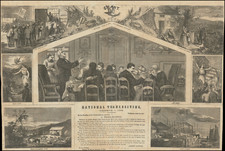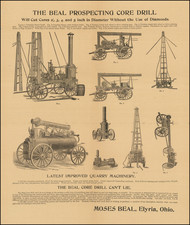De Zuid Zé Compagnie Door Wind In Top Gerezen Beklaagt nu Haar Verlies Met Een Bekommerd Wezen, produced anonymously in Amsterdam in 1720, is an engraved broadside that offers a visual critique of the South Sea Bubble. The central image portrays the personification of the South Sea Company, depicted as a contemplative female figure, encircled by documents and accompanied by four putti, among which Fama is notable. Surrounding this central portrayal are vignettes that display human interactions with money, notably a man swallowing coins, and other scenes illustrating the frenzied trading and labor that epitomized this financial disaster.
The South Sea Bubble was one of the earliest instances of a stock market crash, a phenomenon whereby investors drive up stock prices, only to see them catastrophically collapse. By 1720, the South Sea Company, which had been granted a monopoly to trade with South America by the British Crown, saw its shares skyrocket based on speculation and dubious claims about the potential wealth from these trading ventures. However, the anticipated profits did not materialize, leading to rapid loss of confidence and an ensuing financial crisis.
The broadside's iconography provides a detailed commentary on the speculative mania and its aftermath. The South Sea Company's allegorical figure, deep in thought amidst a tempestuous background, is a potent representation of the enterprise's fraught journey. The putti, especially the figure of Fama - the personification of fame and rumor - emphasize the role of misinformation and rumor in inflating the bubble. The peripheral images, particularly the man ingesting money, evoke the insatiable greed and irrationality that characterized the period.
In this artifact, the juxtaposition of thought-provoking images and the verses in three columns, printed from a separate plate, weave a multifaceted narrative. It captures the fervor, chaos, and ultimate disillusionment of a society caught in one of history's most infamous financial maelstroms. The piece is not just a representation of the South Sea Bubble, but also a larger commentary on the transient nature of wealth and the dangers of unfounded speculation.










![[The Gospel of John - Eagle]](https://storage.googleapis.com/raremaps/img/small/49807.jpg)
![Comparative Size of Lakes and Islands [Great Lakes, Cuba, Formosa, Ireland, Sicily, Cyprus, Vancouver, Sandwich Islands, Puerto Rico, Corsica, Sardinia, Balearics, Malta, etc]](https://storage.googleapis.com/raremaps/img/small/100135.jpg)

![[World Map / Malaria / Dr. Seuss ] This is Ann . . . She drinks blood!](https://storage.googleapis.com/raremaps/img/small/73499.jpg)
